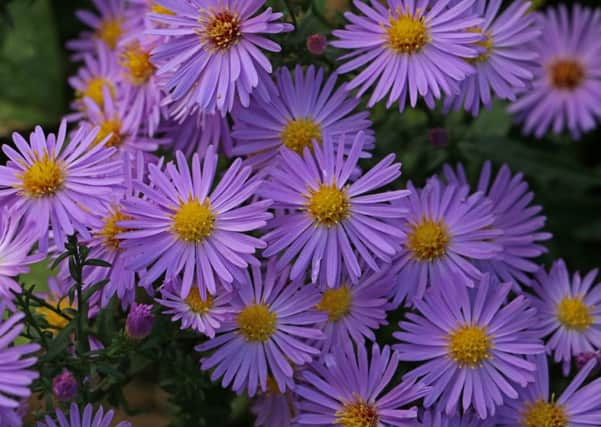Michaelmas daisy '˜aster' be the one for autumn colours


September is a great planning and planting month so start ordering those new roses, shrubs, bulbs and other plants that you need.
Autumn is really the best time for planting, the soil is still warm and the seasonal rains will get plants established before winter sets in.
Advertisement
Hide AdAdvertisement
Hide AdKeeping colour in borders for as long as possible is also at the top of the ‘to do’ list, so you may like to consider incorporating late summer or autumn flowering plants such the aster.
Also known as the Michaelmas daisy, as it flowers around the time of Michaelmas Day on September 29, the aster has long-lasting bloom appeal which makes it a great cut flower.
Asters come in blue, purple, red, pink and white each with a yellow centre and are easy plants for beginners to try in the garden.
They thrive well in drained, fertile soil that retains moisture and prefer full sun or partial shade.
Advertisement
Hide AdAdvertisement
Hide AdOther options for autumn colour are favourites such as the Japanese anemone which are tall and bold with their simple flowers in shades from pink to white, sedum with foliage colours from green to grey and deep purple and flowers in eye-catching white, pink and red, or the great all-round performer verbena valued for its tall branching stems topped with clusters of purple flowers.
September is when autumn begins to creep into your garden, but that doesn’t mean it’s time to let it all go to seed – far from it.
Gardening experts at the Royal Horticultural Society say: “September is generally a cooler, gustier month than August and the days are noticeably shorter.
“While there’s not as much to do in the ornamental garden at this time of the year, if you have a fruit or vegetable patch, you’ll be busy reaping the rewards of harvest.
Advertisement
Hide AdAdvertisement
Hide Ad“It’s also time to get out and start planting spring-flowering bulbs for next year and you can collect seeds for next summer’s colour too.
“Make the most of the remaining warmth while you can.”
David Domoney, TV gardener and presenter, adds: “Summer-flowering herbaceous perennials can be lifted and divided this month.
“Most perennials need to be divided every three to five years, as the plants get too big for the space and become congested.
“Tender perennials like fuchsia, petunia, salvia, verbena, penstemon and chrysanthemum are all propagated by cuttings – just find some strong, young growth that hasn’t flowered this year, and cut beneath a leaf joint, making a cutting of five to 10 centimetres.
Advertisement
Hide AdAdvertisement
Hide Ad“Strip off the leaves from the lower stem, leaving just one or two pairs.
“Dip the end in hormone rooting powder, replant in pots of compost and put them in a propagator for six to 10 weeks.
“Once cuttings have rooted you can re-pot them.
“Finally, give hedges and evergreens a last trim to keep them looking tidy through the winter.”
If you grow your own then harvesting top fruit such as apples and pears begins in earnest in September.
Advertisement
Hide AdAdvertisement
Hide AdLook for fruit falling under the tree (windfalls) to indicate which apples are ready, but also assess taste and texture to determine whether they are ripe for harvesting.
You should also continue to provide support for heavily-laden fruit tree and bush branches.
It’s also a good time to order new fruit trees, canes and bushes.
Continue to sow vegetables for overwintering, to mature next spring, including: turnip, spinach, winter lettuce and Oriental vegetables.
Sow green manures such as crimson clover and Italian rye grass to act as a soil improver and to cover bare areas.
When dug in, they conserve nutrients and improve soil texture.